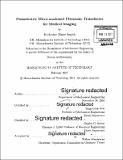Piezoelectric micro-machined ultrasonic transducers for medical imaging
Author(s)
Smyth, Katherine Marie
DownloadFull printable version (19.14Mb)
Alternative title
PMUTs for medical imaging
Other Contributors
Massachusetts Institute of Technology. Department of Mechanical Engineering.
Advisor
Sang-Gook Kim and Charles G. Sodini.
Terms of use
Metadata
Show full item recordAbstract
Next generation medical imaging technology hinges on the development of cost effective and array compatible transducers making piezoelectric micro-machined ultrasonic transducers (pMUTs) an attractive alternative to the current bulk piezoelectric technology. This thesis aims to realize pMUT potential starting with the development of an effective single cell model that is further scaled to optimize multi-cell elements in a 1D array. In the first half of this work, a transverse mode, lead zirconate titanate (PZT) pMUT plate cell is fabricated using common micro-fabrication techniques and a PZT sol-gel deposition process. Through derivation using a novel Greens function solution technique, an equivalent circuit model with explicitly defined lumped parameters is presented and validated through electrical impedance measurements of fabricated devices and finite element modeling. The equivalent circuit is a crucial design tool as transducer performance metrics, including experimentally validated acoustic domain values, are shown to be defined directly from the lumped parameters. In the second half, figures of merit are identified from these performance metrics and an expanded multi-cell model is employed to strategically target improvements in both bandwidth and coupling while maintaining high pressure output. The resulting, optimized multicell elements in a 1D array are fabricated via a commercially viable, wafer-scale manufacturing process including a novel PZT dry etch. A top-down fabrication approach facilitates achievement of the largest active area of a multi-cell pMUT to date consisting of over 1000 cells in a 200pm x 4mm element footprint, and more substantially, results in the highest electromechanical coupling recorded for a pMUT to date measured at 9 ± 1.4% per element.
Description
Thesis: Ph. D., Massachusetts Institute of Technology, Department of Mechanical Engineering, 2017. Cataloged from PDF version of thesis. Includes bibliographical references (pages 175-184).
Date issued
2017Department
Massachusetts Institute of Technology. Department of Mechanical EngineeringPublisher
Massachusetts Institute of Technology
Keywords
Mechanical Engineering.